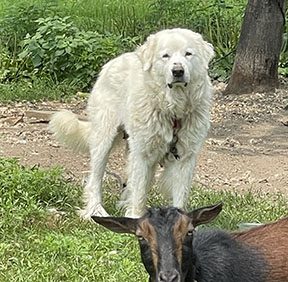
Why did you get an LGD?
53% of american households own dogs. All breeds of dogs were bred with intension and purpose. Rat Terriers were bred to control the rodent population in any given area, while a German Shepard was bred for protection. Even newer breeds like the labradoodle were bred with purpose. Willy Conron started the labradoodle breed in 1989 to create guide dogs for people with allergies to animals. Because different breeds have different purposes, not all breeds of dogs are good protectors of livestock. LGD or livestock guardian dogs are very specific breeds because they exhibit certain character traits such as trustworthiness (in that they don’t roam off and are not aggressive toward livestock), attentiveness (they are aware of predators and threats), and protectiveness (drive off predators that threaten their flock or herd). They must develop a strong bond with the livestock becoming a part of the herd or flock. An LGD lives with his/her herd or flock at all times. Some LGD breeds are Great Pyrenees, Anatolian Shepard, and Meremma Sheepdog. Our future LGD in training is a Great Pyrenees.
Why do I need an LGD (livestock guardian dog)? There are many reasons people choose to get LDG’s. Their reasons depend on the needs of the farm. The reason we have chosen to add a Great Pyrenees to our farm is because we have a fox problem. For the last couple of years, fox have been taking our chickens right out of the pasture. We have tried many different remedies such as beefing up our fencing and attempting to train one of our “house dogs” to be out with the livestock during the day (which turned out unsuccessful as he is not bred for that purpose) and setting up a have a heart trap. Nothing we have tried has impacted the fox coming whenever he is hungry to the buffet of animals on our farm. There are other solutions such as keeping the chickens locked up but on our farm I keep our animals as happy and healthy as possible and the happiest healthiest chickens are free range. I also worry in the springtime that a fox might get bold enough to grab a baby goat in the field. If we shot the fox, that would only be a temporary fix as other predators will soon come along when they realize they can get easy meals. Also, I don’t want to harm animals wild or domestic.
Adding a livestock guardian dog to the farm creates a safe situation for both the livestock and the wildlife. The presence of an LGD is often enough to keep predators such as fox and even bobcats away from the livestock. If his/her presence isn’t enough, the barking and advances of such a large dog will make the predator run away. This creates a much safer environment for all involved and it takes away the worry of losing an animal to predators allowing me to focus on other things.
What about training? Training an LGD dog is very important. You cannot just put a puppy out with your livestock and expect them to just become there guardians. You must train them is the same ways house dogs get trained. They must learn commands such a “leave it”, “sit”, and “stay”. They must learn to walk on a leash; after all, they still need vet visits. Different breeds of LGD’s have different grooming needs but they all need to learn to stand for grooming. Beyond the normal training, LGD’s require additional training. They need to be with you at all times when they are with the livestock so they can be supervised and guided on proper behavior around the animals. A puppies instinct is to play, wrestle and bite but that is not acceptable behavior to do with the animals he/she is being trained to protect. The best training is preventing bad behaviors from forming. Allowing limited supervised times with the livestock is the best way to go about training. There is a lot of knowledge about LGD’s and when it is a good time to get one as well as why it may not be a good time to get one. If you are looking into getting an LGD, I suggest doing lots of research. I researched for a good two years before I made the decision to get one. It does require a lot of work on the handlers part but the reward is definitely worth the effort that you put into the training.
